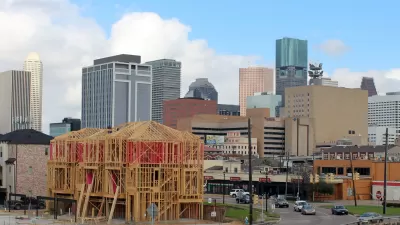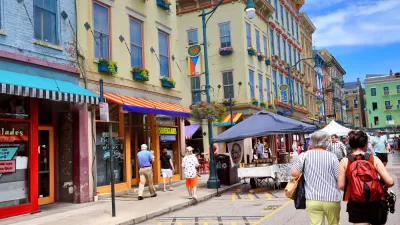While the southern end of the thoroughfare is seeing rapid redevelopment and gentrification, the northern end has yet to reap any benefits from the nearby projects.

Cincinnati's Vine Street is starting to show a stark divide between its gentrifying southern end and the largely ignored section north of Liberty Street, reports Monique John for WCPO Cincinnati. In 2001, the fatal shooting of Timothy Thomas by a Cincinnati police officer sparked days of protests in the neighborhood. "The gentrification that took place on Vine south of Liberty can be explained as an attempt toward social reform triggered by Thomas’s killing." But despite the transformations happening a block away, John writes, "Northern Vine has remained in its distressed state."
Andy Hutzel, director of resident services at Over-the-Rhine Community Housing, contends that the historic nature of the housing stock on Northern Vine plays a role in the slow redevelopment of the area, explaining that "rehabilitating old buildings that dominate OTR comes at a hefty price." Local stakeholders are hopeful that plans to extend revitalization efforts to the north will come to fruition soon, and "experts project that the urban core’s rapid development in recent decades likely will not slow down as it moves into the northern portion of Over-the-Rhine."
Other locals worry about the displacement and higher cost of living that usually come with redevelopment. "Vulnerable residents are hungrier for amenities like laundromats, social spaces, and food establishments that they can afford." To address these concerns, "investing in affordable housing will be key to protecting vulnerable residents like those living on or near northern Vine from the drastic changes to come."
FULL STORY: Will gentrification keep climbing up Over-the-Rhine's Vine Street?

Trump Administration Could Effectively End Housing Voucher Program
Federal officials are eyeing major cuts to the Section 8 program that helps millions of low-income households pay rent.

Planetizen Federal Action Tracker
A weekly monitor of how Trump’s orders and actions are impacting planners and planning in America.

Ken Jennings Launches Transit Web Series
The Jeopardy champ wants you to ride public transit.

Rebuilding Smarter: How LA County Is Guiding Fire-Ravaged Communities Toward Resilience
Los Angeles County is leading a coordinated effort to help fire-impacted communities rebuild with resilience by providing recovery resources, promoting fire-wise design, and aligning reconstruction with broader sustainability and climate goals.

When Borders Blur: Regional Collaboration in Action
As regional challenges outgrow city boundaries, “When Borders Blur” explores how cross-jurisdictional collaboration can drive smarter, more resilient urban planning, sharing real-world lessons from thriving partnerships across North America.

Philadelphia Is Expanding its Network of Roundabouts
Roundabouts are widely shown to decrease traffic speed, reduce congestion, and improve efficiency.
Urban Design for Planners 1: Software Tools
This six-course series explores essential urban design concepts using open source software and equips planners with the tools they need to participate fully in the urban design process.
Planning for Universal Design
Learn the tools for implementing Universal Design in planning regulations.
Ada County Highway District
Clanton & Associates, Inc.
Jessamine County Fiscal Court
Institute for Housing and Urban Development Studies (IHS)
City of Grandview
Harvard GSD Executive Education
Toledo-Lucas County Plan Commissions
Salt Lake City
NYU Wagner Graduate School of Public Service





























